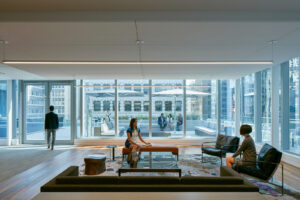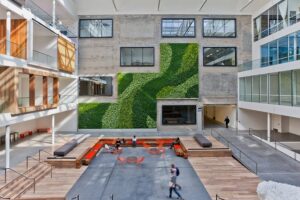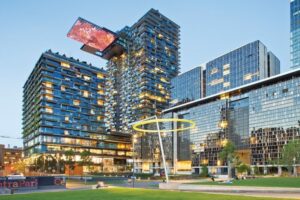As work evolves, it’s crucial to understand the new paradigms shaping our workplaces. Welcome back to our Unworking Weekly mini-series, inspired by new book “Unworking: The Reinvention of the Modern Office” by Philip Ross & Jeremy Myerson.
Over the past eight weeks, we have explored the themes of each chapter, offering insights into the book’s vision for the future of work and the workplace. Offices have been integral to society for the past century, influencing everything from city architecture to daily routines. However, the pandemic triggered a re-evaluation of the office’s role, promoting a shift away from outdated practices. As we enter the ninth week of our series, we explore Chapter 9, continuing our journey through the evolving landscape of work.
This week’s blog focuses on Chapter 9: Designing. The design and configuration of physical space in the workplace play a critical role in shaping employee experience, productivity, and collaboration. This chapter examines how the principles of design are being reimagined to create workspaces that not only serve functional purposes but also foster creativity, well-being, and innovation.
Designing, in the context of work and the workplace, refers to the strategic and thoughtful creation of environments that support various workstyles, enhance employee well-being, and encourage collaboration.
This approach to design is about more than just aesthetics; it’s about integrating functionality with a deep understanding of human behaviour and needs within a workspace. The goal is to craft environments that are adaptable, inclusive, and conducive to both individual focus and collective engagement.
Designing for Flexibility and Adaptability
One of the key themes in this chapter is the emphasis on designing spaces that can adapt to the evolving needs of the workforce. As workstyles become more varied, with a mix of in-person, remote, and hybrid models, the design of office spaces must be flexible. This includes reconfigurable furniture, multi-purpose areas, and technology-enabled environments that can easily transition between different uses. Flexibility in design is essential for supporting the diverse ways in which people work today, allowing organisations to maximise the utility of their space and enhance overall employee satisfaction and productivity.
Flexible design often incorporates modular components that can be rearranged or repurposed depending on the activity or number of occupants. Multi-functional spaces can quickly shift from meeting rooms to open workspaces or even social areas. Technology plays a pivotal role in this adaptability, enabling seamless transitions between different modes of work, whether employees are on-site, working remotely, or moving between both.
Deloitte’s Toronto office demonstrates flexible and adaptable design with its activity-based working approach. Employees choose from various workspaces, including quiet zones, collaborative areas, and casual lounges, depending on their task. The office features movable walls and modular furniture, allowing spaces to be reconfigured as needed. Advanced technology supports seamless remote communication and collaboration, enhancing productivity and accommodating diverse workstyles. This design not only maximises space utility but also empowers employees with the flexibility to work in ways that best suit their needs.

Human-Centred Design
Another major theme is human-centered design, which places the needs, behaviours, and well-being of people at the forefront of the design process. This approach goes beyond functionality, focusing on creating environments that actively enhance the quality of life and work for employees. By prioritising comfort, accessibility, and emotional well-being, human-centered design aims to foster a supportive and engaging workplace culture.
Key elements of human-centered design include ergonomic furniture that promotes physical health, the use of natural light to improve mood and productivity, and the integration of spaces that encourage social interaction and collaboration. This approach not only addresses physical and mental comfort but also aims to create a sense of belonging and community among employees. Essentially, it transforms the workplace from not only a functional space but into a nurturing environment that supports and motivates its occupants.
Airbnb’s headquarters in San Francisco is a great example of human-centered design. The workspace is constructed to reflect the diverse needs and personalities of its employees, providing a range of environments from peaceful, quiet zones for focused tasks to vibrant, open areas designed for collaboration. This design approach prioritises physical comfort with ergonomic furniture and natural light, while also addressing mental well-being through spaces that encourage social interaction and community building.
The headquarters features a variety of amenities that cater to different work styles and preferences. For example, there are quiet nooks equipped with soundproofing for individuals needing deep concentration, as well as open, flexible spaces for team brainstorming and informal meetings. The incorporation of communal areas, such as cafes and lounges, promotes organic interactions among employees, fostering a strong sense of community and enhancing overall job satisfaction. Additionally, the design reflects Airbnb’s brand values, creating an environment that feels both inclusive and engaging.

Sustainability and Well-Being in Design
This chapter also highlights the growing importance of sustainability in workplace design. Sustainable design practices not only reduce the environmental impact of office spaces but also contribute to the well-being of employees by creating healthier, more comfortable environments. This includes the use of sustainable materials, energy-efficient systems, and biophilic design elements that bring nature into the workplace.
One Central Park in Sydney stands out as an excellent model of sustainable workplace design. This mixed-use development includes office spaces that embrace sustainability through a range of innovative practices. The building features vertical gardens, architecturally designed to integrate nature into the urban environment, enhancing both aesthetics and air quality.
The project utilises energy-efficient systems, such as advanced HVAC and lighting controls, which reduce the building’s carbon footprint and operational costs. Additionally, the use of recycled and sustainable materials throughout the construction process contributes to the overall eco-friendliness of the design. The incorporation of green spaces and natural elements not only promotes environmental responsibility but also creates a healthier and more pleasant atmosphere for occupants, supporting their physical and mental well-being.

The discussion of design in contemporary workplaces highlights the importance of creating environments that are not only functional but also flexible, human-centered, and sustainable. As organisations rethink the role of the office, design becomes a critical tool in fostering innovation, well-being, and adaptability.
Readers can dive deeper into the exploration of workplace design and its impact on the future of work in Philip Ross and Jeremy Myerson’s latest book, Unworking: The Reinvention of the Modern Office. By understanding these design principles, we can create dynamic, inclusive, and sustainable work environments that meet the needs of today and tomorrow.
